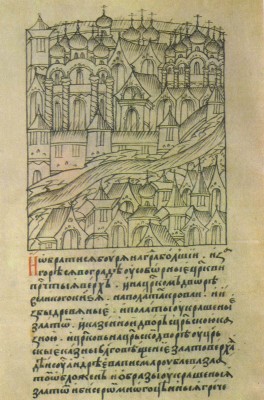Methods of Studying Manuscript Texts of Literary Works
Texts of literary works discovered in manuscripts are studied, first of all, from the point of view of whether or not they have been published. If the work is already known, it is essential to ascertain whether the text that has been found corresponds to the known texts, whether it has any special features and to which of the published texts it bears most resemblance.

16th-century semi-uncial—a page from The Tsar’s Book showing a fire in Moscow in 1547. History Museum, Moscow
If the researcher wishes to study all the texts of a certain work, he must first try to locate these texts from existing scientific descriptions, printed and handwritten, by examining manuscripts not yet described in which there may be new texts. He then divides all the texts he has found into groups. If there is a deliberate effort in one group of manuscripts to give a special text for certain ideological, stylistic or other considerations, this group of texts is called a redaction of the work. If another group does not show any deliberate effort to change the text, but is merely a version of the text formed as a result of errors in the process of copying it and the more or less successful correction of these errors, such a group of texts is called a type or version of the text. If a group of manuscripts contains local features of language or dialect, united by the general process of copying the text in a given country or locality, such a group is called a recension. There may, for example, be a Novgorodian, Ukrainian, Byelorussian, Bulgarian, Serbian, or Moldavo-Wallachian recension. Sometimes a recension coincides with a redaction (the scribe introduces not only special linguistic features, but also deliberate changes). Occasionally a text that has been copied in different places and countries has mixed recensions: Ukrainian-Serbian or Bulgaro-Russian, for example. This means that the text was copied first in one country, then in another, and that it bears the imprint not of one language, but two or even three. In the Middle Ages manuscripts written in a literary language that could be understood in several Slav countries were often transferred from one, country to another, donated, sold, and so on. It might happen that a Russian scribe was working in Bulgaria, on Mount Athos or in Constantinople, or that a South Slav scribe came to Russia where he not only copied books, but also wrote himself (for example, the Bulgarian Metropolitan Cyprian, Pachomius the Serb and others, see below).
The study of the handwriting of manuscripts, the material on which they were written, and the texts of literary works is made by special disciplines, such as palaeography and textology.2
 History of Russian Literature
History of Russian Literature
